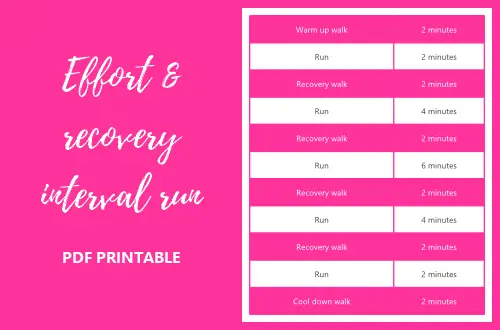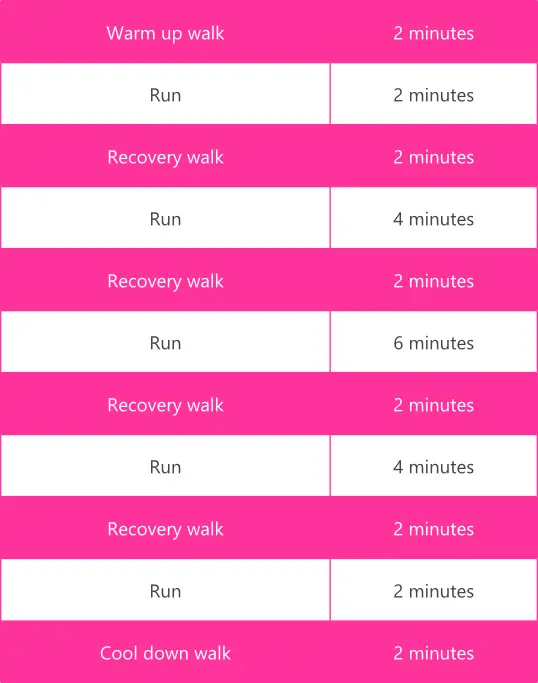Effort and recovery interval runs are a popular form of training that involve alternating periods of high-intensity effort with recovery periods. This system of training can help to improve running endurance and speed. It also adds variety to a running program and for some is more enjoyable than continuous low intensity effort. There is no set format regarding interval length and recovery can be active or complete rest. In general, longer effort intervals combined with shorter active recovery intervals tend to train more for endurance, while shorter all-out efforts combined with longer intervals of complete rest tend to improve speed. However, there is a wide variety of possible combinations, all of which will have slightly different training outcomes.
Short effort intervals are usually performed at near-maximal effort, while longer efforts will need to be performed at sub-maximal effort. The recovery intervals allow the body to recover ready for the next bout of effort. The effort and recovery plan below is designed more to improve endurance and has medium to long effort intervals. Even so, it’s likely to bring about more improvement to speed than continuous running for 30 minutes would.

Benefits of effort and recovery interval running
Improved cardiovascular fitness: The high-intensity effort intervals challenge the heart and lungs, improving their ability to deliver oxygen and nutrients to the muscles, and increasing overall cardiovascular fitness.
Increased endurance: By pushing the body to its limits during the high-intensity intervals, and then allowing for recovery during the rest periods, effort and recovery interval runs can help increase endurance and stamina.
Weight loss: The high-intensity effort intervals burn calories and boost metabolism, which can aid in weight loss and weight management.
Increased speed: By incorporating short bursts of high-intensity effort into your training, effort and recovery interval runs can help improve speed and power.
Reduced boredom: The constantly changing pace and intensity of effort and recovery interval runs can make them more engaging and less monotonous than steady-state cardio workouts.
30 minute effort and recovery interval plan
The recovery intervals are all 2 minutes of walking. This should be normal pace walking, giving your heart rate the chance to come down and your breathing rate to recover. The running intervals are pyramid style, so they increase up to 6 minutes and then decrease back down to 2 minutes.

Before you start this plan, please read these general exercise guidelines.
If you’re doing your intervals on a treadmill, then it’s very straightforward. You just need to set the speed at whatever is your effort running speed or recovery walk speed and do the specified time. If you’re running outside, then you’ll need to decide what sort of route you want:
“There and back” – you run/walk for half the time and then turn around and return along the same route.
Circular route – you plot a route to bring you back where you started without turning and retracing your steps. Your route isn’t necessarily a circle, it could be any sort of shape.
“A to B” – you end up at a different location from where you started. You might run somewhere and get a lift back for example.
If you don’t want the trouble of planning a route, you can choose the “there and back” option. But if you want to follow a circular route or end up at a different location, then it’s useful to use a route planning app.
Timing your intervals
You’ll need a way of timing your intervals. This could be a phone app, a stopwatch or a fitness watch.
Which is better – outdoors or inside?

There are advantages and disadvantages to both indoor and outdoor running
Advantages of the treadmill
With a treadmill it’s easy to set your running speed and keep your speed continuous. You don’t need to worry about route planning and, if you want the challenge of an uphill run then it’s easy to increase the gradient. You also aren’t affected by bad weather.
Advantages of walking outside
On the other hand, the predictable conditions of the treadmill make it less of an all-over body challenge because you don’t have to cope with uneven surfaces and changes in direction. Running in the street or park is also free of course, whereas gym membership or buying a home treadmill can be expensive. You’ll get the benefit of fresh outdoor air, which is good for mental as well as physical health.
Buying a treadmill for home use
Now that folding treadmills are widely available, having a home treadmill doesn’t mean you need a dedicated workout space. You can fold your treadmill up and store it out of the way between walks. If you’re thinking of buying a home treadmill, here are some points you should consider:
- A cushioned running/walking deck will help to absorb impact.
- Dimensions: there’s a slight variation in dimensions between models. If you’re tall, you might prefer a longer walking/running deck to allow for a longer stride. Obviously, the treadmill needs to fit in your chosen storage place when it is folded away.
- What sort of a console do you want? Is it important to you to have a multi-feature console with a choice of preset programs, or will you be happy with something simple that just lets you set speed and incline? Extra functions add to the cost of the treadmill, so think about whether you really need them.
- What is the incline range? Some treadmills only have a limited incline range. Models that offer up to 12% give you more options to vary your workouts and to challenge yourself more as your fitness improves.
- Maximum speed – if you run fast, or plan to do sprint intervals, you should bear the maximum speed in mind. For walking, or average speed running, any treadmill will be fine.
Get a printable of the plan
Share this on Facebook
More running programs


